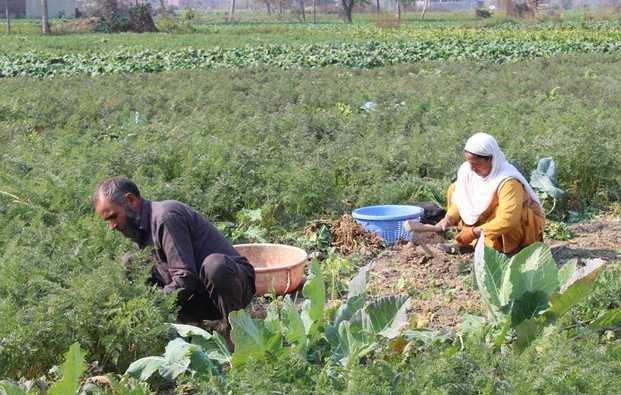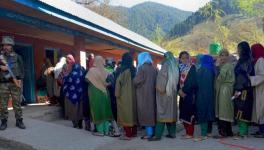New Delhi’s Twin Agenda in J&K – Control Land Use, Destroy Food Security

Representational image. | Image Courtesy: Tribune India
In September 2020, the government of India passed three highly controversial farm Bills – The Farmers’ Produce Trade and Commerce (Promotion and Facilitation) Bill, 2020; the Farmers (Empowerment and Protection) Agreement of Price Assurance and Farm Services Bill, 2020 and the Essential Commodities (Amendment) Bill, 2020.
These Bills, which have now become laws, have created a storm, with the farming community across India protesting and defying restrictions amidst the COVID pandemic. Since then, widespread criticism has poured in discussing the ramifications of opening up of the agricultural sector to predatory profiteering by private capital and consequential marginalisation and pauperisation of the farming community.
Economist Prabhat Patnaik highlights that in this entire debate, an important dimension that has been missed is of food security and the imperialist agenda of robbing the tropical regions off food security and self-reliance, pushing them to become food-import-dependent. As a part of this agenda, agricultural land devoted to foodgrains is diverted to commercial crops – beverages, fibres, vegetables and fruits -- that the first world cannot otherwise grow.
In pursuance of this agenda, the imperialist forces situated in the first world attempt to: 1) acquire control over land use of tropical land-mass; and 2) persuade third world governments to permit diversion of land-use from food-crops to commercial crops, to throw open tropical agriculture to global trade. A movement in this direction directly undermines food-security and self-reliance of the Third World and opens up the arena for unbridled exploitation of its peasantry.
This shift from cultivation of foodgrains to cultivation of commercial crops is reminiscent of the colonial period when the cultivation of export crops, such as opium and indigo, were forced upon the peasantry by the East India Company, Patnaik points out.
It is not surprising then, that post-colonial regimes laid special emphasis on self-reliance and food security. ‘Grow more food’ and ‘miss a meal’ became rallying slogans as the post-colonial Indian state resolved to secure economic independence and feed its citizens without resorting to import of foodgrains.
The ‘Grow More Food Policy’ was also sincerely implemented by the government of Jammu & Kashmir (J&K). The government under Sheikh Abdullah was passionate about making J&K self-reliant in food to realise the twin objectives of economic development and safeguarding the political autonomy of the state, which was threatened in face of prospective economic dependence on the Centre.
Under the ‘Grow More Food Policy’, the then J&K government promoted peasants to cultivate all the cultivable land over which it had ownership rights. In a matter of one year, 1948-49, 185,583 kanals (1 kanal = 0.125 acres) of land was allotted to landless peasants. This resulted in an increase in agricultural produce by 200,000 maunds (1 maund = 37.32 kg).
In a speech at Ranbir Singh Pora in 1952, Sheikh Abdullah announced, “It would be better to die than submit to the taunt that India was our bread-giver.” This was an overly ambitious aspiration, given the paucity of resources and a financial crisis that the state was going through as a result of closure of highways and trade routes with Pakistan and Central Asia following the Partition of India.
Since arranging foodgrain supplies from outside was not an option the government was willing to follow, the leadership tried to persuade people to substitute their staple meal of rice with substitutes. To set an example, Sheikh Abdullah himself ate a meal of maize once a day.
Seven decades since, the social, political and economic situation of the erstwhile state has changed drastically. The autonomy of J&K, eroded for years, was eventually abrogated by the scrapping of Article 370 by the Indian government in August 2019. Consequently, the new farm laws enacted in September 2020 are applicable to what is now the Union Territory of J&K. In this backdrop, it is important to assess the impact that the stormy farm laws will have on the paddy fields of J&K and what it means for food security in the region.
Shrinking Paddy Fields of J&K
Agriculture and allied sectors continue to be the predominant source of livelihood for over 70% of J&K’s population. These sectors contribute nearly 50% to Gross Domestic State Product (GSDP). Despite the fact that foodgrain production in the erstwhile state has trebled since 1950-51, it still meets 40% of foodgrains and 20% of vegetable requirements through supplies from outside.
The net sown area of 7.35 lakh hectares constitutes 35% of the reported area, against the national average of 46%. The Jammu region yields high quality rice, wheat, maize, pulses and oilseeds, while the Kashmir region is known for its production of high-quality paddy and maize in addition to temperate fruits and commercial crops, like saffron, almonds, walnuts, peaches, cherries, apples etc.
Significant progress has been made in the field of horticulture. The area of land under fruit cultivation has increased from 12.4 thousand hectares in 1953-54 to 3.25 lakh hectares at present. Fruit cultivation has reached an all-time high of 22 lakh tonnes now as compared to 16 thousand tonnes in 1953-54. J&K constitutes 60% of apple production in India.
Over the past two decades, agricultural land in J&K has been shirking as a result of diversion of agricultural land for rapid urbanisation. In addition, agricultural focus has gradually shifted from cultivation of foodgrains to commercial and cash crops. Peasants have increasingly found cultivation of paddy to be unsustainable. As a result, they have been switching to horticulture.
Kulgam, once regarded as a rice bowl of Kashmir, is on the way to losing this status. Paddy land is swiftly being converted for housing, horticulture and industrial purposes, drastically reducing the production of rice. This phenomenon is not only restricted to Kulgam but is seen throughout the Valley.
Given that rice is the staple food of people in J&K, a dependence on supplies from outside is a cause for concern from the perspective of food security. From an estimated annual requirement of around 11 lakh tonnes of rice, of which only 5.5 lakh tonnes is met by rice production within J&K, the shortfall is met through supplies from neighbouring states. According to reports, production of rice, wheat and mustard has reduced by 6%, 4% and 4%, respectively. Apart from changing cropping patterns and land use conversion, climate change has affected productivity in Kashmir.
As a result of the new farm laws, cultivation of foodgrains in J&K is bound to take yet another hit. Commercial crops, including apples, almond, walnut, peach, cherry, and saffron will witness an escalation in demand, as this category will increase export prospects, generating greater profits for farmers and private players.
On the other side, cultivation of ‘essential’ crops, including wheat, rice, maize, pulses etc. will plummet. No mention of MSP (minimum support price) and competition from states, such as Punjab and Haryana, will discourage peasants from cultivating this category of crops.
Warning of the far-reaching impact of the new legislations, lawyers at J&K High Court, Viqas Malik and Romaan Muneeb, wrote: “The Proposed Act may leave a tangible impact on the UT of J&K as the farmers might soon shift from Paddy and Maize farming to alternate yields prospecting better monetary compensation; so in 10 years from now while driving across the highway if you don’t find men and women ankle deep water weeding out rice; just recall what happened 10 years back.”
Unabated Conversion of Agricultural Land
In 2015, A senior official from the Department of Agriculture blamed successive regimes for failing to prevent conversion of agricultural land and said: “The government is non-serious to stop this land conversion; otherwise colonies with authorised permission won’t come on paddy land in Srinagar or in other districts.”
Since then, Kashmir has lost around 17% (78,700 hectares) of its agricultural land in four years between 2015-2019. Official data suggests that from 4,67,700 hectares in 2015, agricultural land has shrunk to 3,98,000 hectares in 2019. Land under paddy cultivation has reduced by 5.4% from 148,000 hectares in 2015 to 140,000 hectares in 2018. Similarly, land under maize cultivation has reduced by 24% from 100,000 hectares to 76,000 hectares.
Being a land-scarce state due to mountainous terrain, the percentage of cultivable land to ‘reported area for land utilisation’ was only 26% in 2015-16. Over the years, as a result of shrinking agricultural land, the size of landholdings has reduced to 0.54 hectares (in comparison with the national average of 1.66 hectares).
According to the Economic Survey 2014-15, arable land in J&K has shrunk from 0.14 hectare per-person in 1981 to 0.08 hectare per-person in 2001 and further to 0.06 hectare per-person in 2012. All of these factors have made farming non-remunerative for the peasantry. It is not surprising that the state has been facing a deficit in food and is increasingly dependent on food supplies from neighbouring states.
Tracing the discourse on land policy of the state, two parallel and paradoxical trends come to the fore. While on one hand, the sharp decline in agricultural land has raised alarm bells in official circles in Kashmir, a parallel push is visible in the administration allowing construction of commercial complexes, shopping malls, schools and service centres on agricultural land in the Valley. This continues despite the existence of a legal framework enacted precisely to prevent – 1) loss of agricultural land in the land-scarce region, and 2) protection of land rights of the peasantry after hard fought land reforms of the 1950s and 1970s.
Land laws in J&K were enacted to strictly prohibit transfer of land to non-residents of the state and regulate conversion or transfer of agricultural land to non-agricultural uses. The provisions of the Jammu and Kashmir Alienation of Land Act, 1938, Big Landed Estates Abolition Act, 1950 and Jammu and Kashmir Agrarian Reforms Act, 1973 provided for these strictures.
Further, the conversion of vegetable lands, floating fields and orchards was regulated through Jammu and Kashmir Land Revenue Act, 1939 and Jammu and Kashmir Prohibition on Conversion of Land and Alienation of Orchards Act, 1975.
In 2016, the Department of Revenue promulgated a policy regulating change of land use. The 2016 policy stated: “In absence of a housing policy, the enforcement of the Land Laws pertaining to the land use has become almost impossible because the violator is left with no option but to take recourse to change of land resource available with him.” It proposed a procedure to seek permission for land-use conversion till a comprehensive Housing Policy is formulated. Despite the presence of this legal framework and policy measures, reckless and unplanned conversion of agricultural land in J&K continues unabated. The situation is bound to get worse in future.
After the abrogation of Article 370 and revocation of Article 35A, land laws in J&K have been amended to allow transfer of land to non-residents of J&K. Further, land laws are being liberalised to open up the land market for Indian capital in the name of ‘development’. Liberalisation of land laws and opening up of the land market for global trade is intrinsic to the neoliberal economic order. As explained by Patnaik, a push for conversion of agricultural land for non-agricultural purposes is a part of this agenda. Despite relentless resistance of Kashmiris, the Indian state continues to enforce this imperialist agenda in J&K.
Released in February 2019, the Srinagar Master Plan of 2035 insists on the need for a comprehensive revamping of the legal umbrella for the effective implementation of the plan for urbanisation. The plan recommends amendments to ‘static and archaic concepts of land ownership’ of legislations governing planning and development of towns in J&K for dynamic planning and development. The laws falling under this umbrella include the Jammu and Kashmir State Town Planning Act, 1963, the Jammu and Kashmir Development Act, 1970 and the Jammu and Kashmir Municipal Corporation/Municipal Act, 2000.
In 2020, New Kashmir Policies have been introduced concerning land-utilisation, real estate etc. The new J&K Housing, Affordable Housing, Slum Redevelopment and Rehabilitation and Township Policy, 2020 sanctioned in July 2020 proposed incentives such as exemptions from building permit fee, external development charges and ‘land use conversion’.
In addition to agricultural land, 727 hectares of forest land has been identified for diversion. Out of this, 33% (243 hectares) of forest land was approved for diversion for the use of the Army and paramilitary forces between September 18, 2019 and October 21, 2019. Already, government records suggest that the Indian military has grabbed 53,353 hectares of land in Kashmir under. This includes occupation of agricultural land, forest land, state land and private buildings.
Since August 2019, around 15,000 acres of land in Kashmir and 42,000 acres in Jammu (mostly around eco-sensitive zones) has been identified for infrastructural development. In February 2020, an area of 7,500 acres of the state land had been identified and earmarked for industrial development.
New Delhi’s Two-Fold Agenda
The first agenda of the Indian government in J&K, served through the new farm laws, is a direct attack on food security. Fostered dependence (of J&K on the Centre), Haseeb Drabu (former J&K finance minister) had argued, has been created in the system over the years, which is the best way to keep the government in control. The more the erstwhile state becomes dependent on supplies of foodgrains and other items from neighbouring states, the easier it becomes for New Delhi to ‘manage’ Kashmir. It was to avoid this stranglehold by India, that the earliest government under the Prime Ministership of Sheikh Abdullah struggled to protect the autonomy and self-sufficiency of J&K.
The second agenda of New Delhi is to attack any remnants of an arrangement that allows land use to be determined by social welfare, rather than private profitability. As Patnaik writes, “Since land is a scarce resource, land use must be socially controlled. It cannot be dictated by considerations of private profitability. True, since land is in the possession of the peasants, they have to be looked after even while land use is being socially controlled. They must, in short, get a remunerative price even as land-use is being socially controlled… This is what the existing arrangement tried to achieve, which the present government wants to destroy… Imperialism would like such destruction; and the BJP government is happily obliging.”
As a predominantly agrarian society, where social control over land use and land rights for the peasantry was institutionalised through rigorous reforms, the people of J&K stand to lose immensely at the hands of this agenda of destruction.
The writer is an author and a researcher with Tricontinental: Institute of Social Research. The views are personal. She can be reached on Twitter @ShinzaniJain.
Get the latest reports & analysis with people's perspective on Protests, movements & deep analytical videos, discussions of the current affairs in your Telegram app. Subscribe to NewsClick's Telegram channel & get Real-Time updates on stories, as they get published on our website.
























